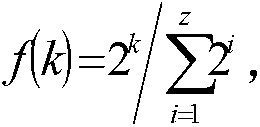Dynamic resource management method based on sliding window
A sliding window and dynamic resource technology, which is applied in the field of cloud computing or distributed computing, can solve problems such as preempting all resources, algorithm inadaptability, resource waste, etc., to ensure resource quality, improve execution success rate and execution efficiency, and reduce resources wasteful effect
- Summary
- Abstract
- Description
- Claims
- Application Information
AI Technical Summary
Problems solved by technology
Method used
Image
Examples
Embodiment 1
[0049] In Embodiment 1 of a sliding window-based dynamic resource management method provided by the present invention, the available resource r in the system i The collection of Φ is dynamically changing. According to the performance indicators of resources, ordinary resources and excellent resources are distinguished, and ordinary resources and excellent resources are stored in ordinary resource pools respectively. base and excellent resource poolΦ vip , initially, Φ base = Φ, Φ vip Is empty. resources i The degree of excellence is based on the resource evaluation function V(r i ) to get, V(r i ) The larger the value, the resource r i more excellent. V(r i ) will send the record to r in the past period of time i The execution success rate of the task is proportional to the average execution time, and is directly proportional to the task execution success rate, and inversely proportional to the average task execution time.
[0050] Task t to be scheduled in the syste...
Embodiment 2
[0061] In Embodiment 2 of the present invention provides a dynamic resource management method based on a sliding window, the pseudocode of the data structure of the resource used is:
[0062]
[0063]
[0064] A dynamic resource management method based on a sliding window, comprising the following steps:
[0065] Initialize the common resource pool pool_base to store all resources;
[0066] Initialize the excellent resource pool pool_vip to be empty;
[0067] The priority of the initialization task is 1~z, and the priority is greater than z 0 tasks are important tasks, and the rest are ordinary tasks. In this embodiment, z=9, z 0 =5;
[0068] Initialize z task queues task_queue(1), task_queue(2), ..., task_queue(z) to store tasks with different priorities;
[0069] The maximum number of resources for initializing the candidate resource pool is n 0 =5;
[0070] Initialize the sliding window initial size ω 0 =0.2;
[0071] Initialize the sliding window adjustment s...
PUM
 Login to View More
Login to View More Abstract
Description
Claims
Application Information
 Login to View More
Login to View More - R&D
- Intellectual Property
- Life Sciences
- Materials
- Tech Scout
- Unparalleled Data Quality
- Higher Quality Content
- 60% Fewer Hallucinations
Browse by: Latest US Patents, China's latest patents, Technical Efficacy Thesaurus, Application Domain, Technology Topic, Popular Technical Reports.
© 2025 PatSnap. All rights reserved.Legal|Privacy policy|Modern Slavery Act Transparency Statement|Sitemap|About US| Contact US: help@patsnap.com



